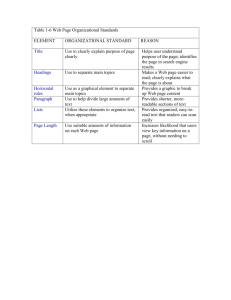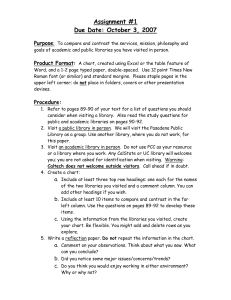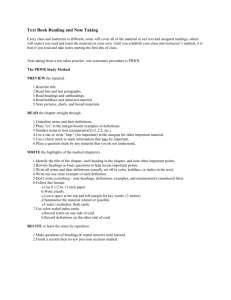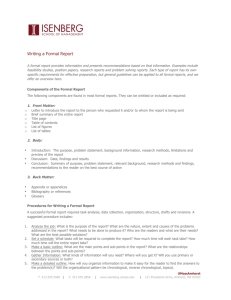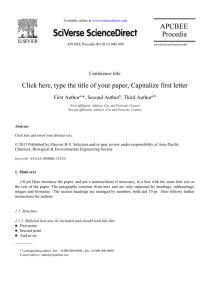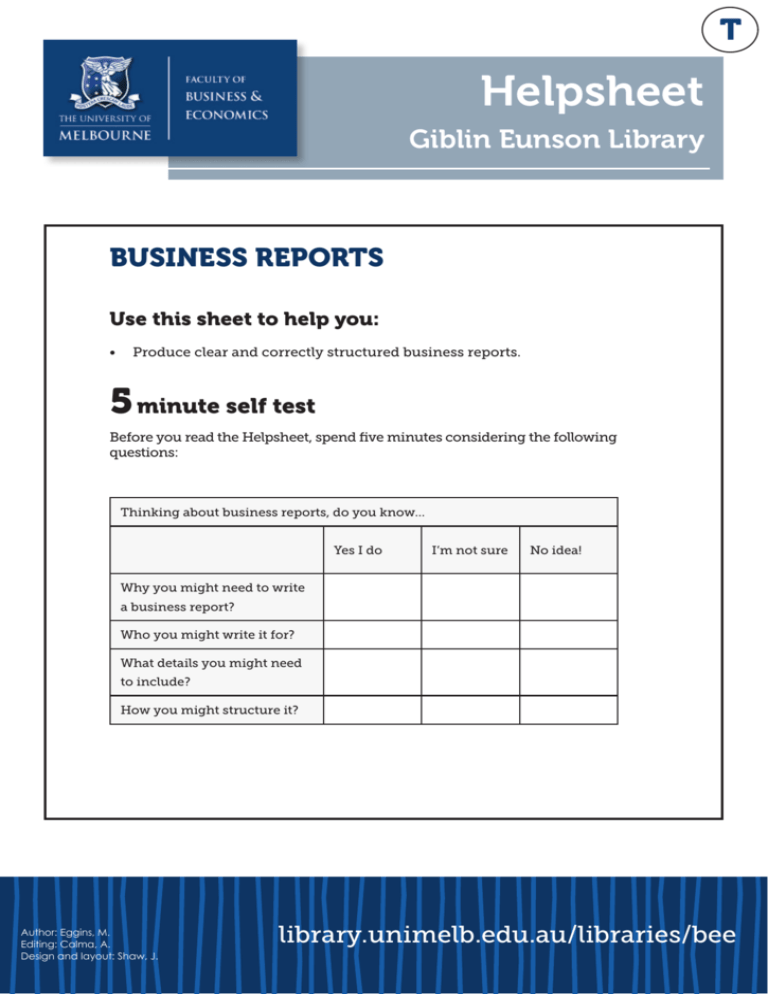
T
Helpsheet
Giblin Eunson Library
BUSINESS REPORTS
Use this sheet to help you:
• Produce clear and correctly structured business reports.
5 minute self test
Before you read the Helpsheet, spend five minutes considering the following
questions:
Thinking about business reports, do you know…
Yes I do
I’m not sure
No idea!
Why you might need to write
a business report?
Who you might write it for?
What details you might need
to include?
How you might structure it?
Author: Eggins, M.
Editing: Calma, A.
Design and layout: Shaw, J.
library.unimelb.edu.au/libraries/bee
BUSINESS REPORTS
T
1. What is a business report?
Organisations need accurate, timely, objective and concise information to make
effective decisions. One way they can obtain such information is from a business
report. This document can be defined as “an organised presentation of information to
a specific audience for the purpose of helping an organisation achieve an objective”
(Bowman & Branchaw, 1988, p. 12).
While business reports share similar characteristics, they also need to be customised
for their particular purpose. An informal report may be a brief summary while longer
reports follow a more complex and formal structure.
Informal reports may feature:
•
•
•
•
•
letter or memo format
minimal use of headings and visual aids
personal pronouns and contractions
a length from a few paragraphs up to five pages
content primarily for internal audiences
More formal reports however tend to have:
•
•
•
•
•
•
a more standard format organised into separate sections
front and back matter (sections) along with the body of the report
a greater number of headings (including subheadings) and visual aids
third person pronouns and no contractions or slang
a length from five pages to several hundred
content designed for internal and/or external audiences
2. Why do I need to write a business report?
Formal business reports often feature in university assessment tasks in disciplines
such as accounting, management and marketing as writing such reports is an
essential skill in business. These tasks may require giving information only (i.e.
financial statements), information and interpretation (i.e. product surveys) or offering
information, analysis and recommendations.
A report that details the last type could highlight a problem and suggest a solution
which might involve analysing a business’s history, operations, problems, competition
and goals, followed by a number of possible solutions (including their advantages
and disadvantages). Following this investigation, a specific solution might be
recommended to aid future growth.
Please note that business reports have some of the same features as research reports.
For more information on the latter please see the Study and Research Helpsheets Research Reports and Report Checklist.
Page 1
library.unimelb.edu.au/libraries/bee
BUSINESS REPORTS
T
3. How do business reports differ from essays?
An accessible reader-centred style which includes standard formal English is a
hallmark of academic writing including in essays or reports. However, there are some
key differences between the two genres:
Purpose
Format & Struc-
Essays
Business Reports
Articulate a point of view in rela-
Often recommend action to solve
tion to a particular proposition
a specific problem
Have introduction, body and con-
Always have sections clearly
clusion sections that normally do
divided by numbered headings
not use headings
(and often sub-headings)
ture
Use cohesive paragraphs to link
ideas rather than list dot-points
Typically don’t normally need an
Abstract
abstract as readers read the text
carefully from start to finish
Graphics
Writer
Reader
Rarely use graphics as written
evidence
Are generally the result of individual work
Are written for the lecturer/tutor
or other academic audiences
Use shorter, more concise paragraphs and dot-points where
applicable
Always have an abstract (or
executive summary) as readers are
typically ‘time poor’ and skim and
scan through the text quickly
Feature graphics (such as tables
and graphs) for supporting main
points
Are often the result of group work
Are addressed to a specific
audience (i.e. client or manager)
established by the topic
Page 2
library.unimelb.edu.au/libraries/bee
BUSINESS REPORTS
T
4. How do I write a business report?
There are several major steps typically involved in writing a business report. These
include:
1)
2)
3)
4)
5)
planning (including determining the scope and target audience)
researching, organising, evaluating and analysing your information sources
drafting the body section
devising conclusions and recommendations based on the findings
further drafting and editing/proofreading
You need first to consider exactly what you have been asked to do - that is - the overall
purpose of your report. Carefully considering the assessment task and related criteria
should help you clarify:
• your objective and readership
• what information you need
• the format and level of detail required
From this, prepare an outline (including a working title and the overall structure of the
report, including the major and supporting ideas). Start on your draft early so you can
develop your ideas (editing can come later).
Who is your audience?
Your readers are your priority. Note that while business reports are typically written by
‘specialists’ for ‘generalists’ (most commonly the decision-makers in organisations),
there can be a number of audiences for any one report.
Therefore carefully consider your readers’ likely:
• prior knowledge and experience with the background information, technical
language, concepts and contexts covered in the report
• interest in and possible opinions regarding the report’s topic
Ask yourself the following questions:
•
•
•
•
What do my readers know and think about the topic?
What background, definitions and other information do they need?
What questions or objections might they raise about the issue/s?
Is my audience ‘internal’, ‘external’ or both?
- Is it for readers up, across or down the hierarchy of the organisation and/or people from outside?
Page 3
library.unimelb.edu.au/libraries/bee
BUSINESS REPORTS
T
If you can identify and assess your audience well, then you can match your content,
visuals and structure to their level of expertise. Keep in mind for example that the
higher up the chain of command a report it goes, the more condensed and formal it
should be. A more general audience, in contrast, needs less technical vocabulary and
more explanation. In addition, if writing the report as a group, ensure consistency by
agreeing about content, structure and presentation (including fonts and headings, line
spacing and indenting) before drafting and also allocate each group member a specific
role (including what area they need to research).
How should I begin gathering information?
Along with your key audience, you will also need to establish the key concepts
and issues you are dealing with to generate keywords for your research. Consider
whether or not your report needs either primary and/or secondary data. The former
depends on first-hand sources from your own research (i.e. interviews, surveys and
observations) while secondary research involves using existing information based on
other people’s investigations.
Allow time to read widely to locate the best resources remembering that your report
should be supported by documented sources which are authoritative, current, reliable
and relevant. In particular, to ensure objectivity, if you are doing a report on a
particular organisation, don’t solely rely on information from them.
If you quote, paraphrase, or summarise someone else’s ideas, acknowledge them
appropriately. This will usually include indicating 1) the family name of the author, 2)
date of publication, and 3) the page number when used in the text. Record these details
on a separate page too at the end of the report in your reference list where you need to
include other information such as the title, publisher and city of publication. Keeping
a ‘research diary’ (listing such useful information as your keywords, successful search
strategies and notes about indexes/databases) is also recommended.
To ensure you have researched widely, use the library catalogue and the Discovery
search function - the catalogue lists book and journal titles (both paper copies and
electronic) while Discovery gives you access to databases, allowing access to full
text articles and also includes company, country and industry reports, data and
statistics. The library also has lots of other assistance available including individual
research consultations and the specialist librarians at the Gilblin-Eunson Business and
Economics Library.
What format and structure should I use?
As you begin taking notes it is useful to arrange an outline of your report – especially
its particular sections – so you can ‘fill in’ these as you go along (leave the introduction,
conclusion and recommendations for later). Focus here on your ideas, evidence and
logical flow. Dividing your report into sections also ensures the information in your
report is easy to find and follow. Sections need to be clearly labelled with headings and
sub-headings outlining the logical development of your paper. Always check to find
out what is required including the format and length of your sections.
Page 4
library.unimelb.edu.au/libraries/bee
BUSINESS REPORTS
T
The flow of information in your report can be organised in two basic ways – indirectly
or directly. The indirect approach (normally required at university) means you need
to persuade your readers to accept the findings of a report. This basic structure is 1)
background, 2) findings, 3) discussion, 4) conclusions and 5) recommendations. A
direct style however presents the conclusions and recommendations first followed by
an introduction and the findings (it is often favoured in the business world for ‘time
poor’ audiences).
How should I use headings?
Whether you have an indirect or direct structure, headings help organise your report.
If one particular section has a number of components to it, consider sub-headings
under your main heading if necessary. Make sure however, this is done logically so
the connections are clear and the use of font size and style, along with underlining
and capitalisation is consistent (headings normally only have the first letter of the first
word capitalised unless proper nouns are also used).
You can use either functional headings or more descriptive ones that incorporate
content. The former ‘generic’ type focus on what each section does (as in
‘Introduction’, ‘Findings’, ‘Summary’) whereas descriptive headings reflect content
more explicitly. Some reports may combine both, generally starting with the former
category as in ‘Findings: what our survey tell us about our customers.
Try and keep headings short, relevant and consistent. Your headings could use
stand-alone verbs or nouns, adjectives and nouns together, or even more complex
constructions like clauses – including statements and questions. Some examples are
below:
Sample Headings (Noun and noun groups)
Introduction
Background to the issue
Service changes
Productivity improvements
Future developments
Conclusions
Recommendations
Sample Headings (more complex noun groups & clauses)
Why did ABC merge with XYZ?
The main issues related to ABC/XYZ merger implementation
What can be done to improve any merger problems?
Should ABC consider any other mergers?
Specific recommendations for action
Page 5
library.unimelb.edu.au/libraries/bee
BUSINESS REPORTS
T
Whatever headings you use, repeat some or all of the information in each heading in
your first sentence underneath it rather than using the headings as an introduction to
your text:
Issues with the merger
A number of issues arise relating to the merger concerning both organisations.
These are arising from considerations relating to both organisations.
Headings are normally numbered both in the contents page and the text itself. This
system uses a combination of numbers and decimal points to do this (see the example
below). Do this consistently for all headings and subheadings, using indenting to
show the divisions:
1. Current Market Penetration
1.1 Australia
1.1.1 Sydney
1.1.2 Melbourne
1.1.3 Other states
1.2 Asia Pacific region
1.3 Other international markets
2. Possible Expansion Strategies
2.1 Online
2.1.1 Company website
2.1.2 Other Internet shopping options
2.1.3 Social media and ‘virus’ marketing
2.2 Television
2.1.1 Product placement
2.1.2 Celebrity endorsements
2.1.3 Sponsorship
5. What are the particular sections of a business
report?
In terms of the elements of a formal report (that uses an indirect approach) there are
three basic parts:
Page 6
library.unimelb.edu.au/libraries/bee
BUSINESS REPORTS
T
1) Front Matter
• Cover
• Title Page
• Executive Summary
• Table of Contents
• List of Figures
2) Body of the Report
• Introduction
• Findings and Discussion
• Conclusions
• Recommendations
3) Back Matter
• Appendices
• References
• Glossary (if required)
Front Matter
The front matter includes the cover, a title page, an executive summary (abstract),
a table of contents, and a list of figures (if you have more than five). A letter of
transmittal - a kind of official ‘cover letter’ - is sometimes required in the business
world (not normally a university requirement). Note that all pages in the front matter
are numbered using small Roman numerals.
Title page
When considering the actual title of your report ensure that it is somewhat neutral and
thus does not imply any particular pre-determined outcome. Your title page should
comprise:
•
•
•
•
•
•
•
the full title (centred, in bold or upper case)
the person/organisation it was prepared for (optional)
the person or people who prepared it (and student numbers where required)
the due date
the lecturer/tutor’s name
the name of the subject (and its code)
no page number (but is counted as a page)
While the above is a general guide, please check with your lecturer/tutor as each
assessment task may have its own specific requirements:
Page 7
library.unimelb.edu.au/libraries/bee
T
BUSINESS REPORTS
Table of contents
If your report is over several pages, a table of contents helps readers to locate
information quickly by giving them an overview. All section headings and
subheadings should be included, worded and numbered exactly as they appear in the
text. You might include a list of illustrations on a separate page (if you have more than
5 graphic aids). A list of appendices needs the appendix letter (each separate appendix
labelled as Appendix A, Appendix B, etc.), its title and page number. A glossary may
also be required if you have a large amount of unfamiliar vocabulary, symbols,
abbreviations and/or acronyms.
Table of Contents
Page
1.
Introduction1
2.
An overview of the product
1
2.1 Main features
1
3.
Product benefits2
3.1 Reducing heating costs
2
3.1.1 Heating cost reductions by season 2
3.1.2 Further savings through thermostat use 3
3.1.3 Other associated savings
4
3.2 Improving house resale value
4
3.3 Reducing household bacteria
5
4.
Advertising strategies
4.1 Traditional media
5
4.2 Web 2.0
6
5.
Conclusions6
6.
Recommendations6
Bibliography7
Appendices
A. Product development specifications
9
B. Advertising budget
10
Executive summary
An executive summary or ‘abstract’ is very important as some readers may only
read this part. Write it last, being sure to include a summary of all parts of the report
(omitting examples unless essential) including the:
Page 8
library.unimelb.edu.au/libraries/bee
BUSINESS REPORTS
•
•
•
•
•
T
‘why’ (purpose)
‘what’ (scope or breadth of the investigation)
‘how’ (methodology)
‘what you found out’ (major findings with key statistics)
‘so what’ (analysis, conclusions and recommendations)
It should be a half to one page (around 5% - no more than 10%) of the overall length and
on a separate page.
Body
Introduction
Your introduction is really the ‘start’ of the report so describe here why your report is
being written answering such questions as ‘what is this about?’ and ‘how is it useful?’
This is also where your page numbering starts. Specifically you need to:
• give some brief background information
• define the problem/topic, its relevance, scope and any key terms
• state the overall purpose (are you explaining, analysing, recommending or a
combination?) and key objectives
• give an overview of the report’s structure including the sections and their
relationship to the issues
• detail assumptions, theoretical foundation, scope, methodology and any
limitations or constraints
As this section details the whole structure of your report, you may wish to do it last
when most of the report has been written.
Findings and discussion
In your findings and discussion sections, present a factual outline followed by an
interpretation of what you found. Note that a frequent complaint from lecturers is
that there is too much description and not enough analysis regarding what findings
actually mean. This section is usually the longest part of a report and forms the basis of
your conclusions and recommendations. As a result, record all significant information
(both positive and negative) and ensure you have a logical internal structure – this
could be based on such organisation as chronology, order of importance, general to
specific, regions or topics.
Findings can be presented in text and/or graphically. If using graphs or figures, see
the relevant section in this helpsheet for more detail on how to do this. This section
should reflect the structure outlined in the introduction. It may try and answer
questions like:
• What were the most significant findings or factors involved in the topic/ problem?
• Did the findings support the theory?
• Did you uncover any unexpected or new issues that need to be considered?
Page 9
library.unimelb.edu.au/libraries/bee
BUSINESS REPORTS
T
To discuss such questions you may include:
•
•
•
•
support that the results provide for the hypotheses
a comparison of results with other relevant theory and/or investigations
factors which may have influenced your results, e.g. design problems
implications of the results
Ensure that you do more than just describe – instead make it clear the significance
of what you are talking about and how it might relate to the conclusions and
recommendations. Phrases such as ‘therefore it is clear that X is important in Y’ or
‘With this result in mind, it follows that X is…’.
Conclusion
Your conclusion summarises your study - its purpose, process and findings. You need
to include your main ‘opinion’ here, answering the questions raised by your original
purpose so there is a thematic unity to your report and the recommendations follow
logically. You may also need to consider the limitations and advantages of findings
and any unresolved questions or issues. Avoid including any new information.
Adjectives are useful in a conclusion as a way of condensing your main points:
‘This report therefore clearly highlights that the advertising campaign was very
successful, due to its inclusive and far-reaching impact with key target audiences such
as X and Y’.
Recommendations
Recommendations are the suggested actions based on the report findings. They must
be both relevant and feasible covering:
• What needs to be done
• Who needs to do it
• How, when (in what order if appropriate) and where it needs to be done
Recommendations could be for change, improvement or new ideas to improve such
areas as service, productivity or performance. They can be listed one at a time (often
numbered). Be sure you use a consistent sentence structure for all recommendations
(some examples are below). Think carefully also about the order they are in and
whether or not it would be useful to group them into appropriate content areas.
These include:
• verb (directive)
Hire more technical staff to deal with the ongoing quality control issue
• passive with ‘it’ as the ‘dummy’ subject
It is highly recommended that more technical staff be hired to deal with
the ongoing quality control issue
Page 10
library.unimelb.edu.au/libraries/bee
BUSINESS REPORTS
T
• specific subject in passive voice
Technical staff should be hired to deal with the ongoing quality control issue
• specific subject in active voice
Management consider alternative funding arrangements for the new venture
Back Matter
Appendices
Your appendices (if required) contain optional material at the end of your report,
containing specialised (sometimes technical) information that may have been too
detailed or lengthy to include in the body. Appendices can be in any format, however,
each appendix must be separate from the others, covering only one kind of content
and format on separate pages. They are generally distinguished by letters of the
alphabet – e.g. Appendix A, Appendix B, Appendix C, and can be referred to in the text
of the report (i.e. “for the full list of suppliers refer to Appendix B”).
References
It is essential to include an accurate reference list of the material you used in your
report. You will need references when you have included any material (including
statistics, facts and opinions) which is not yours. As there are several referencing
systems, check with your lecturer, tutor or department for guidelines on how to
reference and do this accurately and consistently as lecturers will notice mistakes in
the reference list.
6. Do I need to add tables and figures?
Adding graphics to your report such as charts (pie, bar, line, organisational and
flow), tables and timelines is a useful aid for your readers. This is because they can
more clearly illustrate and reinforce your main points (especially for comparisons
and projections). They are most commonly used in the findings section if they are
essential to understanding the text. If they are more ‘supplementary’ (such as raw
data), put them in the appendices. In any case, they should:
• be clearly and consistently labelled (i.e. x and y axis with the table title flush left
with any source required) and referenced if taken from an outside source
• be placed as close to the written text they match to avoid confusion
• feature distinct shading if the report is printed in black and white
In addition, think carefully about how important the information is – that is do
you want to include visuals in the body of the report to support your text or in the
appendices for further reference?
When referring to visuals, subordinate them to your main idea as in ‘As Table 1
shows…’, ‘As shown in Table 2,’ or highlight as in ‘Table 1 demonstrates…’ or ‘Figure 2
clearly indicates’. Moreover, be consistent with table and figure titles (in most cases,
table titles precede the tables while figure titles follow the figures). Do not leave the
Page 11
library.unimelb.edu.au/libraries/bee
BUSINESS REPORTS
T
reader to interpret your data, but rather supply explanations in your text, e.g. ‘Table 1
shows the proportion of consumers who did not take up the premium plan option’.
Industry Players
Harvey Norman Holdings
Limited
Ownership
Public Parent
JB Hi-Fi Limited
Public Parent
The Good Guys
Public Subsidiary
Dick Smith
Public Subsidiary
Strathfield Group
Public Company
Video EZY
Private Company
Blockbuster
US Based Company
Tables
Tables show information (words and/or numerical data) in rows and columns. They are
especially useful in portraying details, relationships and comparisons.
Table 1: Industry Players by Ownership
Source: Melbourne University Department of Accounting and Business Information
Systems (2010).
Graphs
Vertical bar and line graphs are useful
to demonstrate trends. More complex
information can be segmented or be
presented using multiple bars.
Figure: Vertical Bar Graph (segmented)
Figure 3. New Store Sales Growth Rate vs
Comparable Store Sales Growth Rate
Source: Calma Corporation (2010)
Page 12
library.unimelb.edu.au/libraries/bee
T
BUSINESS REPORTS
Figure: Multiple Vertical Bar
Graph
Figure 4. Financial Performance:
Percentage of Net Income
Source: AC Holdings (2010)
Language for discussing tables and graphs
Use appropriate language to refer to the significant details in your charts and tables.
Verbs like ‘show’, ‘refer’, ‘highlight’ and ‘underscore’ help emphasise the points in your
visuals:
• This figure refers to the domestic sales only, however...
• The last two bars in the bar graph represent the strong increase in share
performance across the whole portfolio.
• The strongest performing affiliate is X as highlighted in Graph Y
Verbs to use in describing tables and figures
articulate, demonstrate, describe, illustrate, represent, show
accentuate, affirm, agree with, assert, emphasise, establish, highlight, maintain, stress,
suggest, support, underscore
contradict, disagree with, dispute, refute
When you are commenting on trends, you can choose from at least two basic patterns.
Describing trends: two basic grammatical patterns
1
2
Subject
Verb
(specific)
Adverb (optional)
Profits
increased
significantly
Subject
(‘There’)
‘be’ verb
Article
‘a’
or ‘an’
Adjective
(optional)
Noun
Preposition
‘in’
Object
(topic)
There
was
a
significant
increase
in
profits.
The table on the following page contains some words you can use for the two patterns
mentioned above to describe trends.
Page13
library.unimelb.edu.au/libraries/bee
BUSINESS REPORTS
T
Words to describe trends
Adjectives (can also be changed to become adverbs)
Small change
constant, gentle, gradual, incremental, insignificant,
minimal, moderate, modest, slight, slow, small, steady
Larger change
abrupt, dramatic, enormous, erratic, large, marked,
notable, overwhelming, sharp, significant, steep,
substantial, sudden, swift, wild
Nouns (can also be changed to become verbs)
Increase ▲
ascension, ascent, climb, doubling, growth,
improvement, increase, jump, lift, peak, recovery, rise,
rise, rocket, surge, tripling
Decrease ▼
crash, decline, decrease, deterioration, dip, drop, fall,
fall, nosedive, plummet, plunge reduction, slide, slump,
weakening
Flattening ▲ or ▼ then ►◄
bottoming out, levelling off, plateau
Fluctuation ▲▼▲▼
difference, fluctuation, movement, variation
To back up your claims, you may want to give extra information from the graph or
figure such as a statistic (which may be a precise figure or an approximation) and the
relevant time period.
Subject
Verb
(specific)
Statistic + time period
Sales
increased
…by one quarter/about 25%/over 20 000 units last year.
…to over two million dollars/to their highest level since last year.
…in all outlets, from just under 20% in 2007 to 25% in 2008, rising
again in 2009 by 10% to a peak of 35%.
Page 14
library.unimelb.edu.au/libraries/bee
BUSINESS REPORTS
T
7. How can I make my report reader-friendly?
Once you have completed a first draft, look more closely at your style, language,
grammar and presentation. Check other members’ sections in the final draft to ensure
they have adhered to agreed specifications - and all members understand all the
content!
Some specific ways you can make your report ‘reader-friendly’ include:
Presentation
• an easily read and consistently applied font
• numbered headings and generous use of white space (in margins and at the top
and bottom of each page as well as to separate each section)
• consistent use of abbreviations and acronyms
Structure
•
•
•
•
•
•
one main idea per paragraph
each paragraph having a clear topic sentence
short introduction and conclusion paragraphs
longer body paragraphs that develop main points
a strong and concise conclusion
an overall ‘theme’ running throughout the paper – possibly a statement or a
question
Language
• specific, concise and clear language
• consistent and accurate verb tenses:
-
•
•
•
simple tenses (usually the present simple) to express facts, current actions and
conclusions
past tense for completed actions and references
present perfect for things happening in the past up to now
avoidance of emotional language and jargon
the active voice with short sentences and clear actors and actions using specific
verbs and adverbs favoured as in ‘Company X considered the plan carefully’
avoidance of too many sentences starting with words like ‘considering’ and
‘having’ instead briefly subordinating already known information as in:
‘Since X Corporation began operating in this region, some issues have arisen
that have impacted on profits’.
Page 15
library.unimelb.edu.au/libraries/bee
T
BUSINESS REPORTS
8. Business Report Checklist
Yes () or No ()
Business Report Checklist
Audience
Have I clearly identified who my readers are?
Do I know their prior knowledge about the topic?
Have I identified what they need to know?
Will they understand my vocabulary?
Content
Have I used a variety of information sources?
Are my sources relevant, credible, current and referenced appropriately?
Do I have a clear objective that has been met?
Can I put some of my data in the Appendices?
Have I been specific enough – using specific contexts, terms and figures?
Do my conclusions and recommendations flow logically from my
findings and discussions?
If the report was written as a group do I (and other group members)
understand all the content?
Language & Style
Have I used strong, clear and short introductions, main points and
conclusions?
Do I have just one main idea per paragraph?
Do I have a clear topic sentence for every paragraph?
Have I been objective? – that is have I used the third person and the
appropriate level of formality (no contractions, slang, emotional
language)?
Presentation
Have I been consistent in my use of:
•
headings
•
fonts
•
punctuation
•
bold
•
bullet points
•
italics
•
abbreviations
•
acronyms
•
numbering?
Does my presentation overall assist the reader in making the report easy
to follow?
Page 16
library.unimelb.edu.au/libraries/bee
T
BUSINESS REPORTS
References
Bowman, J.P. and Branchaw, B.P. (1988). Business Report Writing, 2nd ed Chicago: The
Dryden Press
Canberra University (n.d.) Academic Skills Centre: Report Writing. Retrieved
January 4, 2011 from http://www.canberra.edu.au/studyskills/writing/reports
Charles Sturt University and New South Wales Department of Education and Training.
(n.d.) Writing a Business Report. Retrieved November 19, 2010 from http://www.hsc.
csu.edu.au/business_studies/intro/writing/writing.html
Eunson, B. (2007). Business Writing, Milton: John Wiley & Sons Australia, Ltd
Kimberley, N and Crosling, G (2008) Student Q Manual, (pp.42-46), (4th ed.) Clayton:
Faculty of Business and Economics, Monash University
Meyer, C. (2010). Communicating for Results: A Canadian Student’s Guide, 2nd ed.,
Ontario: Oxford University Press
Murdoch University. (n.d.) Murdoch University Business School Guide to Business
Report Writing. Retrieved November 19, 2010 from http://bestentrepreneur.murdoch.
edu.au/Guide_To_Report_Writing.pdf
Northern Arizona University. Retrieved December 22, 2010 from oak.ucc.nau.edu/
amk35/FormalReportExample.doc
Searles, G.J. (2009). Workplace Communication: the Basics, 4th ed New York:
Pearson Longman
Wollongong University. (n.d.) Unilearning: Business Report Writing. Retrieved
November 19, 2010 from http://unilearning.uow.edu.au/report/rep_business.html
Page 17
library.unimelb.edu.au/libraries/bee


